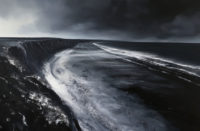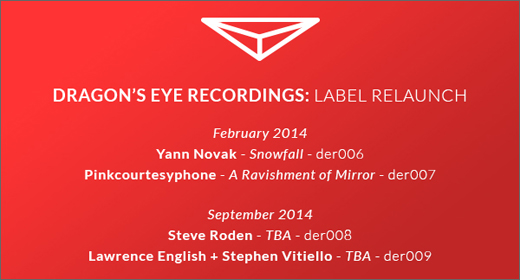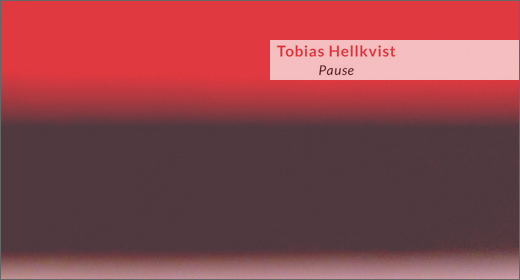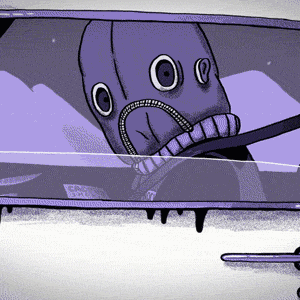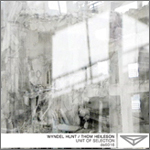
(12.20.08) Dragon’s Eye has grown up fast in the field of designer minimal electronics and drones. Already with a distinctive brand identity forged through an active roster of core artists, it’s now established enough for Yann Novak, Seattleite installation art and sound designer whose baby DE is, to be seeing his main roster-men return with second, sometimes third, offerings. If not exactly seasoned campaigners, these artists are now evidently hardened enough by service in the post-digital frontline to be delivering discreetly different goods than previously: Wyndel Hunt an audio-visual collab with Thom Heilson; Kamran Sadeghi, last seen under the guise of Son of Rose, an exploration of rhythm and spatiality.
First to Unit of Selection, wherein Hunt’s audio pieces are subject for/to digital media artist Thom Heileson’s visualisations. Hunt is a sound designer whose work carries the infinity impulse of drone but here bespeckled with something cinematic and something else vaguely like the ghosts of Autechre Mk.1 discovering shoegaze. Thom Heileson is a visual artist with a penchant for fabricating fictive spaces drawn from photographed and filmed architectures. The collab sprang from realization of thematic commonalities between their sound and video works. Unit of Selection sets out with an ambitious brief: “to fashion new perceptual sculptures, in which the textural fluctuations and movements of each medium carve into one another.” Whether this is achieved is debatable, but the ride is certainly an interesting one.
Hunt’s sonics provide the trigger, conceived around the idea of an “anonymous force that shapes,” which determined movements of pitch, tone, and volume. Heileson based the imagery, on Hunt’s soundworks, bringing out “emotive tonalities” within them. The results range much more widely than Hunt’s earlier brittle minimalism. Unit of Selection has a big warm prickly resonant sound design threaded through with electrified drizzle and steepling drones. Hunt gets much mileage from patching in to a digitalised simulacrum of the post-MBV shoegaze-starburst familiar from Tim Hecker and Fennesz (see esp. “1” and “4”, and the closing minute); that is when not mixing up edit-heavy collages between audio-drama and ambient textural experiment (see “2” and “5”). Track 7 (confusingly entitled “6” according to the liner) effectively combines orientations, a nocturnal hum manoeuvred under welters of fuzz-drone and buzz-tone, swathed in a flicker and shimmer of harmonized static. In fact, static seeps into every corner eventually like aural rust, particularly eerie on penultimate track 9 (confusingly entitled “1”), spreading a sombre dystopian mood redolent of decay and desolation. Heileson’s visuals are not the subject of review here, but they offer effectively synched linkages to Hunt’s compositions with images of environments, sometimes bleached sometimes saturated, reflecting back the richness and glaciality of Hunt’s patterns and colours.
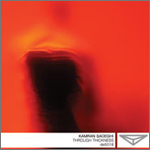
Kamran Sadeghi has previous form as a a dealer in shimmering and sustaining micro-tones under nom de disque Son of Rose. On Through Thickness, though, he operates under his own name for a differently configured sound that expressly takes rhythm as its object of inquiry. Sadeghi purportedly “draws from [the sound’s] potential palate of sonic mass, color, and points in space in order to create compositions of aural depth perception and sculptural form.” The most obvious source from which this work is drawn, however, is the Raster Noton back catalogue; with their staccato stabs, virtual-organic DSP timbres, and blip shtick, Sadeghi’s tracks are sprung from the same furrow ploughed and seeded by Raster’s Main Menschmaschinen – Carsten Nicolai (aka Alva Noto), Frank Bretschneider (aka Komet), Olaf Bender (aka Byetone), and Signal (all of the above Herren). On pieces like “Planar Graph” and “Teeth” Sadeghi cuts and blends clicks and blips into a more cerebral cousin to bleep techno’s rude mechanical. In card-carrying minimalist fashion, Sadeghi starts out parsimonious to a T in his sounds, simple percussive patterns played through Chemnitz-conceived clicks, buzzes and hums. But as things progress he gets busier. Like on the polyrhythms of “Pivot,” with its Flamencoesque of taps and pops suggestive of mechanik tablatronics. Or “Haptic,” a stand-out track, which taps into a similar cybernetic stick figure funk vein, taking it eventually near the double-tempo paradiddling of d’n’b; Sadeghi even manages to programme in a further level of interest here by adding a tonal element to the prevailing orgy of unpitched click, buzz and hum. “Shelter” comes with Sadeghi sounding like he dropped in with his digital bongos on Autechre’s ghost (again) revisiting an early machine-funk session. For all its lab-precise splice digi-science, any suggestion at the outset of starchy austerity in Sadeghi’s sonic processing is banished by the progessive build-up of a satisfyingly corporeal clout.
Both releases are out now on Dragon’s Eye.








